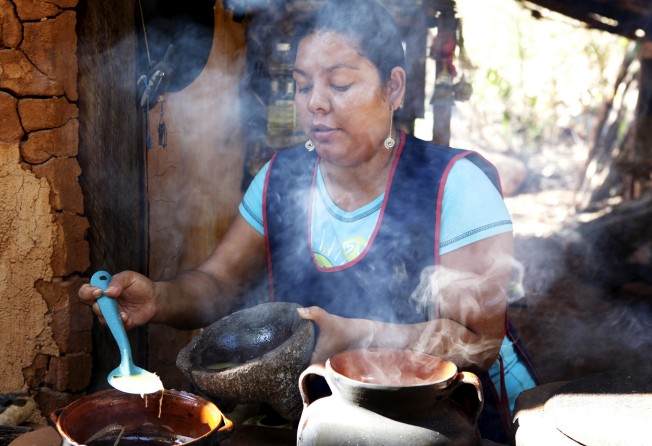Story on a plate: mole

To many Mexicans, mole (pronounced mo-lay) shows their national cuisine at its finest and most complex.
The Spanish word "mole" comes from "molli", which means "sauce" in Nahuatl, the language of the Aztecs still spoken by present-day central Mexicans. The Spanish term is sometimes used to refer to sauce generically but it also refers to a family of Mexican dishes that share similarities but show significant regional variations. Recipes for these dishes may include more than 50 ingredients and take a day to create from scratch, beginning with the process of roasting and grinding fresh spices. The ingredients are blended in order, slowly, and poured over cooked meat, most popularly turkey, but also chicken or pork.
"Mole is the highest point of Mexican cuisine and it's one of the mother sauces of the world," says Martha Ortiz, chef of the award-winning Dulce Patria restaurant in Mexico City's chic Polanco district. "All moles are like a seduction: some moles include more than 50 ingredients - having so many tastes in your mouth is like having a lover. If I had to choose a kiss from a man or a spoonful of mole, I would choose the mole."
But while Ortiz, now on her second husband, sees mole as a sensuous dish, one legend has it that its origins are far more prosaic. In this story, the dish was created in the colonial period by the nuns of the Convent of Santa Rosa in Puebla, near Mexico City. The nuns, having been given short notice of the upcoming visit of the archbishop, put together the ingredients they had to hand at their simple convent to create a dish for their esteemed guest. They added chilli peppers to pieces of old bread, chocolate, spices and nuts, and poured the sauce over a turkey they had roasted. The archbishop loved the dish, and the nuns have cooked and refined the sauce ever since.
Ortiz says that even if this story is true, and she hopes it is, it does not detract from the sensuality of the dish: "My own personal reflection on the story is that the libido has to come out in some way, and if nuns created and recreated the dish, maybe this is why mole is so full of voluptuousness and passion."
Mole is an icon of Mexican cuisine not only because of its complexity of flavour and difficulty of preparation, but also because it blends the indigenous (ingredients such as the chilli and cacao, from which the Mayans created chocolate) with the European (the Spanish imported spices such as cinnamon, coriander and black pepper into Mexico from the 1520s).
Many regions in Mexico have their own moles that incorporate local ingredients and please local palates, but all moles contain chillies, with the most common being mulato, ancho, pasillo and chipotle (smoke-dried jalapenos).
Other ingredients can include onions, garlic, coriander, cinnamon, almonds, peanuts, cloves, sesame, cumin, oregano, pine nuts, and tomatillos, which look like green tomatoes. Chocolate is another ingredient of some moles, especially the famed mole of Puebla, known as mole poblano. The chocolate here is added at the end of the cooking process and is used sparingly so as not to overwhelm the dish by making it too sweet or intense.
Knowing how to balance ingredients in a complex mole is not easy and something that women once learned as part of growing up.
Ivonne Baldwin, whose father is English and mother Mexican, says she grew up watching her grandmother at work in the kitchen. Her grandmother was the majora (matron) of one of Mexico City's iconic restaurants, El Moro, famed for its churros and hot chocolate.
"In my grandmother's day, women didn't become chefs, but she oversaw the kitchen at El Moro. She was a small woman, but tough. She was born in the 1900s and lived through the revolution, and she raised and slaughtered her own guajolotes [wild turkeys]. She was an excellent cook."
In her grandmother's kitchen, chillies and spices were roasted on a comal - a flat hotplate traditionally made from clay, but nowadays made from cast iron. The chillies were then usually soaked in water until they softened, and ground on a metate, a flat stone.
A stone molcajete and a tejolote, equivalent to a pestle and mortar, are also sometimes used to crush the ingredients to powder or paste, depending on the mole. These items are also used in the making of salsa and guacamole.
Mole is usually eaten with rice and tortillas, with the latter traditionally made by hand. During this process the corn is dried, the kernels are removed, toasted and ground on a metate before being patted by hand into shape, and cooked on the comal over fire.
Most people now buy their mole spices pre-ground and packaged in grocery shops, or select the whole spices themselves and take them to a shop to be ground and blended. Moles are still made by hand in some small villages and for big celebrations across Mexico, such as weddings.
While the process of making mole has become simpler to suit the needs of the contemporary cook, Ortiz says the dish has lost none of its significance. Take the mole negro (black mole) of Oaxaca, for example: it gets its dark colour and smoky flavour from the local ancho chilli, the flesh of which is flash fried and the seeds of which are burned. Ortiz says the symbolism of using the ashes of chilli in a dish in a predominantly Catholic country should not be underestimated.
"From ashes to ashes, and dust to dust - there is something poetic, almost like witchcraft, in making a dish using ashes. It's beautiful, feminine and spiritual, as it's a reminder of what we will become," she says.